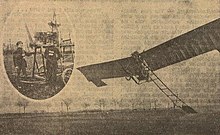Aviation pioneers Bohlen
Aviation pioneers Bohlen was the name given to the brothers Paul, Otto, Heinz and Willi Bohlen from Oberzier , who built the first Lilienthal and Wright aircraft in a wide area between 1912 and 1914 . They tried it out in the Köttenicher field and on the Stockheimer Heide .
The first aircraft the brothers built was a winged bicycle. A propeller set in rapid rotation with forceful pedaling should let the machine fly. But that failed because the device only drove straight ahead.
For the next attempt, the Düsseldorf-based machine factory "Hiels" offered the brothers an aircraft engine for sale. Not only did it cost her the last of her savings, but also the support of aviation enthusiastic friends was necessary in order to be able to purchase the engine . In terms of output, the 80 PS (59 kW) unit should have been enough to take off. But now the construction of the wings proved to be inadequate.
One of the brothers, Otto Bohlen, traveled abroad, initially working in Cambrai in northern France with the aviation pioneer Louis Blériot , the first flying crosser of the English Channel . Later in England he worked for various aviators as a handyman and mechanic and looked around carefully. When he returned to Düren in 1913, he already knew a lot more about aviation.
The flying machine now received newly designed wings covered with smooth, rubberized fabric. In the first attempts at taxiing, the brothers achieved considerable speeds, but it was not enough to leave the ground. Only after many attempts did the flying machine, now named “Bohlen I”, take off in the summer of 1913, not far from Breuer's house in Gürzenich . Controlled by Otto Bohlen, she at least reached an altitude of a few meters.
Shortly afterwards, the hundreds of postcards were sold in Düren, but only very few copies have survived. When the harsh winter of 1913/14 tied the Bohlen brothers to their home, they used the time to build a new flying machine. The "Bohlen II" had matured into a powerful machine and in the summer of 1914 it became the Düren sensation of the year.
The Köttenich field near Aldenhoven , where the brothers last undertook their flight experiments, was no longer sufficient as an airfield , while the Stockheimer Heide proved to be just big enough for a number of flying days . On Saturday, August 1, 1914, one of these flight days, they finally waited for two fellow pilots from Bonn . But while the Loupsche chapel Remember already brisk marches sang to set the mood of the audience burst a horse on the Drover Heide coming Stockheimer policeman in the event, with the news that that war had broken out, considered the First World War into history should. The messenger handed the eldest of the Bohlen brothers, Paul, the call to the Freiburg Aviation School . The next day, Otto, the second oldest, also volunteered in Freiburg. In the further course of the war, the two remaining brothers, Heinz and Willi, were drafted into the fighter pilots . All four survived this war, Otto was even awarded the " Pour le Mérite " medal for bravery . And when the first flight attempts began again in 1926, the Bohlen brothers were there again. They also survived the Second World War .
Paul Bohlen lived in the 1950s as an honorary member of the Kurhessischer Verein für Luftfahrt 1909 e. V. in Marburg . In October 1953 a school glider of the type "SG 38" was christened "Paul Bohlen" on Marburg's market square. At that time Otto worked as a soap manufacturer in Frankfurt am Main . While Heinz lived in Linnich , the youngest of the brothers, Willi, last spent his time in Düren-Rölsdorf in 1954 .
swell
- Düren and the Dürener Land - Dürener Aviation 40 years ago , Dürener Zeitung 1954
